25 Trees with Extended Blooming Periods. Discover 25 exquisite trees and shrubs with extended blooming periods to enhance your garden’s allure. From the elegant Southern Magnolia to the vibrant Flowering Dogwood, explore a curated list that adds color and life year-round.
Selecting the perfect trees and plants for your garden is a delightful yet complex endeavor. As a gardener, you must take into account various factors such as local climate, soil conditions, and the desire to maintain year-round vibrancy in your outdoor space. Rather than relying on a multitude of different trees to keep your garden engaging throughout the seasons, opt for flowering trees and shrubs with the longest blooming periods. Let’s explore a carefully curated list of 25 exceptional choices that will infuse your garden with color, fragrance, and life, attracting both pollinators and birds.
JUMP TO TOPIC
- 1 Table of Contents
- 2 1. Eastern Redbud: A Symphony of Colors
- 3 2. Southern Magnolia: Elegance in Abundance
- 4 3. Flowering Dogwood: A Year-Round Focal Point
- 5 4. Forsythia: A Harbinger of Spring
- 6 5. Hyperion Dogwood: A Play of Cream and Color
- 7 6. Tree Hydrangea: Majestic Summer Blooms
- 8 7. Dream Catcher Flowering Cherry: A Year-Long Showstopper
- 9 8. Smoke Tree: The Enigmatic Smoky Aura
- 10 9. Rhododendron/Azalea: Enduring Elegance
- 11 10. Flowering Almond: Luscious Beauty
- 12 11. Saucer Magnolia: Ephemeral Beauty
- 13 12. Seven-Son Flower: A Global Sensation
- 14 13. Crape Myrtle: Southern Beauty
- 15 14. Chaste Tree: A Fragrant Haven
- 16 15. Higan Cherry: Seasonal Splendor
- 17 16. Japanese Horse Chestnut: Versatile Marvel
- 18 17. Shrub Rose: Timeless Elegance
- 19 18. Oklahoma Redbud: Spring’s Radiance
- 20 19. Flowering Crabapple: Seasons of Delight
- 21 20. American Fringe Tree: Late Spring Charmer
- 22 21. Japanese Tree Lilac: Subtle Beauty
- 23 22. Glossy Abelia: Year-Round Elegance
- 24 23. Hawthorn: A Symphony of Colors and Thorns
- 25 24. Serviceberry: Early Spring Splendor
- 26 25. Goldenrain Tree: Late Summer Radiance
- 27 FAQs about 25 Trees with Extended Blooming Periods
Table of Contents
1. Eastern Redbud: A Symphony of Colors
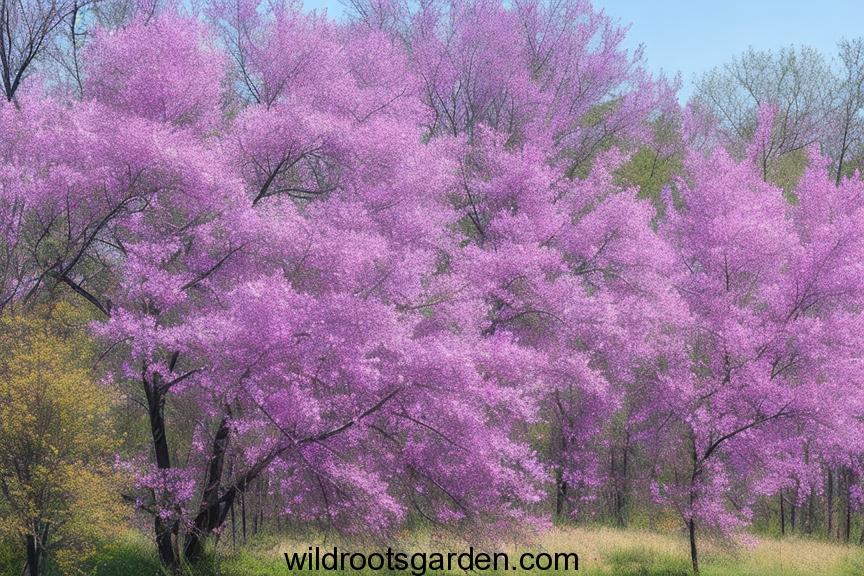
The Eastern Redbud, with its dainty pink flowers, unveils its spectacular display in the spring. As the seasons progress, the blooms shift from pink to red and then purple, adding a captivating transformation to your garden. Resilient in various conditions, this tree flourishes in zones 5 to 9.
The Eastern Redbud (Cercis canadensis) is a true testament to the beauty and artistry of the natural world, creating a symphony of colors that enchants and delights all who encounter it. This enchanting flowering tree is celebrated for its delicate yet captivating blooms, which unfurl in spring like a cascade of pink jewels against the backdrop of awakening landscapes. These exquisite flowers, held on slender stems, are a visual marvel that brings a sense of wonder and renewal to any garden.
What makes the Eastern Redbud truly remarkable is its ability to transform as the seasons progress. The initial pink blossoms give way to shades of red, and then gracefully deepen into a regal purple, showcasing nature’s artistic hand at play. The heart-shaped leaves that follow the bloom phase add another layer of elegance, forming a lush canopy that provides shade and shelter.
Adaptable and versatile, the Eastern Redbud thrives in a variety of growing conditions, making it a popular choice for gardens of all types. Its moderate growth rate ensures that it can establish itself quickly, becoming a cherished presence that endures for years to come. With a height that can reach up to 20 feet, this tree commands attention and adds a touch of sophistication to any landscape.
The Eastern Redbud isn’t just a tree; it’s a living embodiment of the changing seasons and the ever-evolving beauty of nature. Its blooms and foliage come together to create a sensory experience that evokes feelings of awe and connection with the environment. Planting an Eastern Redbud is a choice to witness the enchantment of transformation, a journey that unfolds with every passing season, reminding us of the magic inherent in the natural world. Whether as a standalone feature or part of a larger composition, the Eastern Redbud stands as a timeless masterpiece that elevates the allure of any outdoor space.
2. Southern Magnolia: Elegance in Abundance
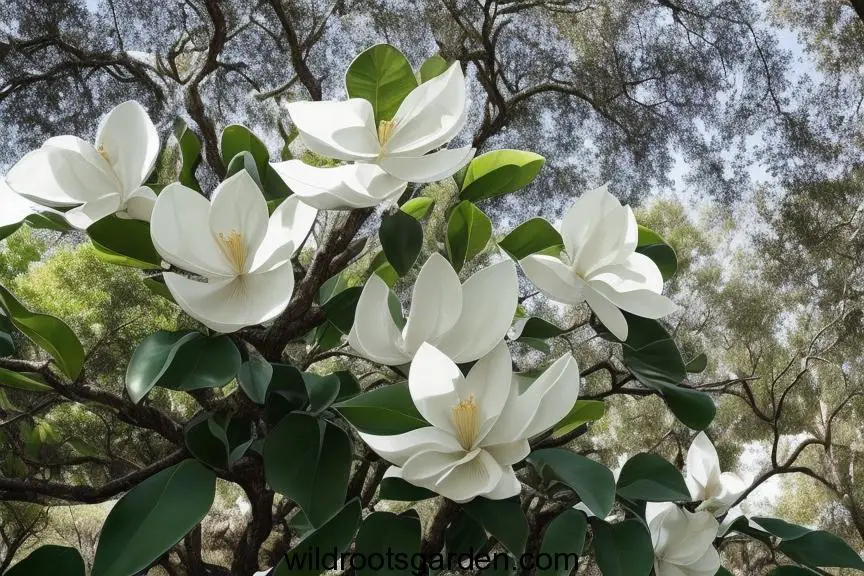
The Southern Magnolia, a hallmark of the South, emanates a divine aura with its vanilla-hued, fragrant blossoms and glossy foliage. It’s an enchanting addition that lends a touch of luxury to any landscape.
The Southern Magnolia (Magnolia grandiflora) stands as a living testament to timeless elegance, gracing landscapes with its regal presence and enchanting fragrance. This iconic flowering tree embodies a sense of grandeur and sophistication that transcends eras, making it a cherished symbol of Southern charm and grace.
Adorning its branches with a flourish of opulence, the Southern Magnolia boasts striking creamy-white blossoms that unfold like delicate works of art. These impressive flowers, often spanning up to 12 inches in diameter, emit a captivating fragrance that lingers in the air, infusing the surroundings with a sense of delicate allure. Against the backdrop of its glossy, dark-green evergreen leaves, the blossoms create a breathtaking contrast that elevates the tree’s visual impact.
The Southern Magnolia’s foliage remains a source of beauty throughout the year. Its leathery leaves retain their glossy vibrancy even during winter, maintaining the tree’s lush appearance regardless of the season. With a mature height that can reach up to 80 feet, this tree possesses a commanding presence that adds a touch of grandeur to any landscape.
Beyond its ornamental value, the Southern Magnolia is deeply ingrained in Southern culture, evoking images of historic plantations and genteel living. It stands as a living symbol of Southern elegance, gracing literature, art, and cinema throughout history. Its versatility in landscaping is a testament to its adaptability, fitting seamlessly into various settings, from expansive estates to cozy gardens.
Planting a Southern Magnolia is a tribute to tradition and a testament to the enduring allure of the American South. It weaves a connection between the past and the present, creating a living legacy that continues to captivate hearts and minds. The Southern Magnolia is more than just a tree; it is a living embodiment of timeless beauty and grace that stands as a testament to the power of nature to inspire and uplift the human spirit.
3. Flowering Dogwood: A Year-Round Focal Point
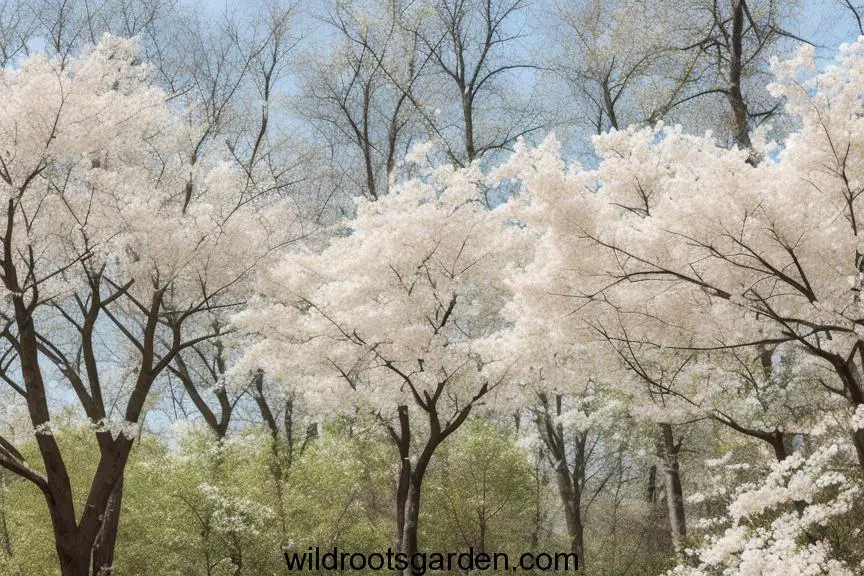
Featuring horizontal branches and lovely pink leaves, the Flowering Dogwood stands out as a focal point even in the colder months when its foliage turns reddish-purple.
The Flowering Dogwood (Cornus Florida) emerges as a year-round spectacle, captivating hearts with its striking beauty and unwavering presence. This remarkable tree transcends the changing seasons, evolving into a focal point that brings enchantment to every corner of the landscape.
Distinguished by its elegant horizontal branches, the Flowering Dogwood extends a warm welcome to every season. As spring unfolds, these branches burst forth with a profusion of exquisite pink blooms that transform the tree into a living masterpiece. These delicate flowers serve as a testament to nature’s artistry, attracting attention and pollinators alike.
As summer takes the reins, the Flowering Dogwood gracefully transitions its blooms into lush green foliage that forms a verdant canopy. The leaves offer shade and solace, inviting observers to bask in its comforting embrace. As the year progresses, the leaves evolve into a rich tapestry of reddish-purple hues, contributing a touch of warmth to the autumn landscape.
Even as winter blankets the surroundings in cold, the Flowering Dogwood remains an anchor of interest. Its unique branching pattern reveals an intricate silhouette against the winter sky, serving as a sculptural focal point that adds dimension to the bare winter landscape.
Adaptable and resilient, the Flowering Dogwood is a symbol of endurance and beauty. Its ability to withstand challenging conditions while maintaining its allure makes it a treasured addition to a variety of landscapes. From small gardens to expansive yards, this tree effortlessly commands attention and adds depth to any setting.
Planting a Flowering Dogwood is an investment in year-round wonder, a commitment to experiencing the ever-changing beauty of nature’s cycles. Beyond its visual appeal, it fosters a connection with the environment, reminding us of the intricate dance of life that unfolds with each passing season. The Flowering Dogwood is more than a tree; it’s a living testament to the artistry of nature and an invitation to savor the splendor that nature graciously bestows upon us.
4. Forsythia: A Harbinger of Spring
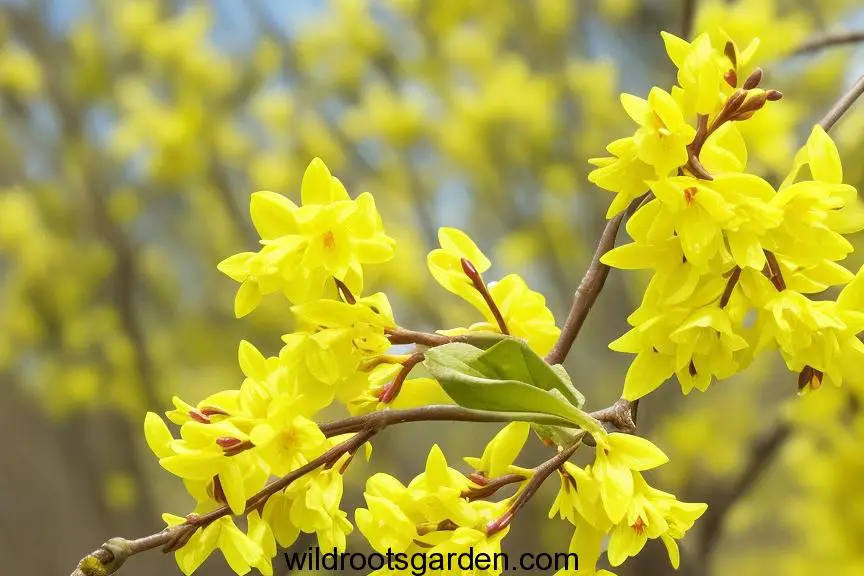
The Forsythia’s vibrant yellow flowers signal the arrival of spring with unmatched exuberance. While often used as an informal hedge, it can also shine as a specimen tree.
The Forsythia (Forsythia spp.) stands as a beacon of hope and renewal, heralding the arrival of spring with its vibrant burst of golden blooms. This remarkable shrub holds the power to transform the landscape, painting it with a radiant hue that banishes winter’s chill and ushers in a season of growth and revival.
As winter’s grip loosens, the Forsythia takes center stage with its arching branches adorned with brilliant yellow flowers. These early bloomers create an arresting sight, signaling the end of the cold and the beginning of a new chapter in nature’s cycle. The Forsythia’s blossoms evoke joy and anticipation, infusing the surroundings with a sense of optimism.
This harbinger of spring is more than a mere visual spectacle; it’s a tangible reminder of nature’s resilience. The Forsythia’s ability to brave chilly temperatures and still erupt in a profusion of blooms showcases its tenacity and adaptability. Its role as a pioneer of warmer days makes it a cherished part of gardens and landscapes, symbolizing the inexorable march of time and the promise of rejuvenation.
The Forsythia’s charm extends beyond its early blossoms. As the seasons progress, its vibrant yellow petals give way to lush green foliage that maintains the plant’s visual allure. The shrub’s versatility shines, as it can be grown as an informal hedge, a screening plant, or even a standalone specimen that draws attention.
Planting a Forsythia is an act of embracing nature’s rhythms and celebrating the cyclical nature of life. It’s a reminder that even in the coldest and darkest of times, there’s a glimmer of warmth and beauty waiting to emerge. As the Forsythia unfurls its golden blossoms, it invites us to revel in the simple pleasures of spring’s arrival and to relish in the promise of new beginnings that each passing year brings.
5. Hyperion Dogwood: A Play of Cream and Color

The Hyperion Dogwood boasts cream-colored flowers in spring, later giving way to small red fruits adored by birds. Its autumn foliage transitions into hues of purple, orange, and gold.
The Hyperion Dogwood (Cornus spp.) graces the landscape with a mesmerizing display that transitions from delicate cream to vibrant hues, creating a captivating play of colors that enchants throughout the seasons. This unique tree is a testament to nature’s artistry, offering a dynamic show that captivates the eye and warms the heart.
In the early months of spring, the Hyperion Dogwood takes center stage with its abundant cream-colored flowers. These blossoms resemble soft brushstrokes on a canvas, creating a gentle and serene atmosphere in the garden. The tree seems painted in a delicate white hue, standing out against the backdrop of awakening nature.
As the spring evolves into summer, the Hyperion Dogwood undergoes a remarkable transformation. The cream blossoms give way to small red fruits that adorn the branches, creating a lively and festive spectacle. These red fruits not only add visual interest but also attract flocks of birds, infusing the garden with movement and life.
The visual journey continues into fall, as the Hyperion Dogwood takes on a new set of colors. Its leaves shift from green to a stunning palette of purple, orange, and golden hues. This stunning foliage adds a touch of drama to the landscape, creating a captivating scene that celebrates the changing seasons.
The Hyperion Dogwood’s ability to evolve throughout the year makes it a versatile addition to various landscapes. Whether planted as a standalone focal point or as part of a mixed border, it commands attention and adds depth to any setting. Its resilience and adaptability ensure that it thrives in different growing conditions, making it a reliable choice for garden enthusiasts.
Planting a Hyperion Dogwood is an invitation to witness the dance of colors that nature orchestrates throughout the year. It serves as a reminder that beauty is not static but a dynamic and ever-changing phenomenon. As the tree transitions from cream to red to a kaleidoscope of autumnal shades, it beckons us to appreciate the intricate rhythms of the natural world and find solace in its harmonious play of colors.
6. Tree Hydrangea: Majestic Summer Blooms
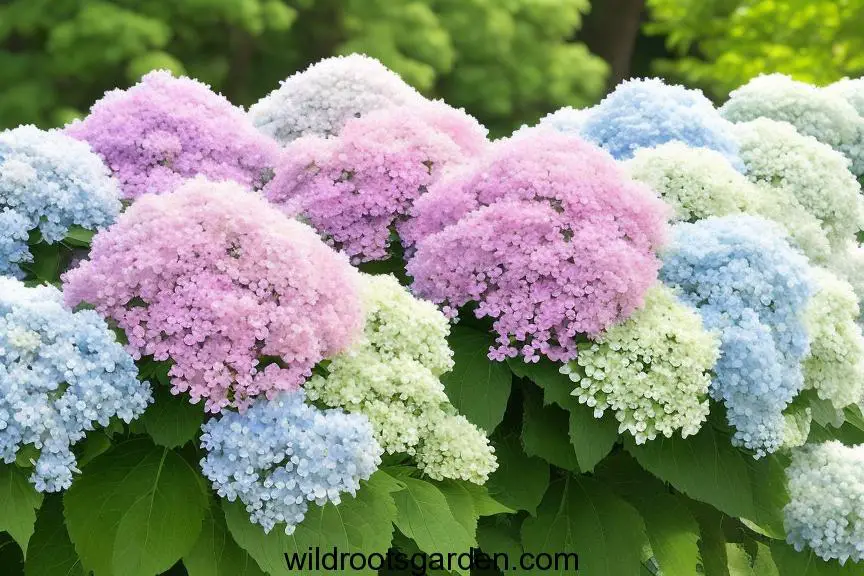
A testament to strength, the Tree Hydrangea bears large cone-shaped white flowers in summer, which gracefully evolve into reddish-brown hues that last through winter.
The Tree Hydrangea (Hydrangea paniculata) stands as a true marvel of summer, gracing gardens with its majestic and exuberant blooms that paint the landscape with shades of pure elegance. This remarkable tree-like shrub brings forth a profusion of cone-shaped white flowers that elevate the spirit and transform outdoor spaces into enchanting havens of beauty.
As summer takes center stage, the Tree Hydrangea unfurls its blossoms in a breathtaking display of opulence. The large, creamy-white flowers cluster together in an arrangement reminiscent of delicate snow cones. These blooms, held aloft on sturdy branches, evoke a sense of awe and wonder, inviting observers to bask in their ethereal beauty.
The Tree Hydrangea’s distinctive feature lies in its ability to transform as the season progresses. While the summer flowers begin as pristine white, they gradually evolve to adopt a reddish-brown hue as autumn approaches. This transition adds depth and visual interest to the landscape, creating a dynamic and ever-changing tapestry of color.
Beyond its striking blooms, the Tree Hydrangea’s structure and foliage contribute to its overall allure. Its upright growth habit and strong branches give it a tree-like presence, adding vertical interest to gardens and landscapes. The dark green leaves provide a lush backdrop that enhances the impact of the flowers, creating a harmonious composition that appeals to the senses.
The Tree Hydrangea’s beauty is not confined to its visual appeal; its enchanting fragrance adds an extra layer of sensory delight to the garden. The sweet scent of the blossoms wafts through the air, creating an inviting and soothing ambiance that entices both humans and pollinators.
Planting a Tree Hydrangea is an invitation to embrace the splendor of summer and revel in nature’s grandeur. It’s a testament to the fleeting yet powerful beauty of the season, a reminder to appreciate the transient moments that nature offers. As the Tree Hydrangea graces the garden with its majestic blooms, it encourages us to pause, immerse ourselves in the present, and find solace in the simple magnificence of the natural world.
7. Dream Catcher Flowering Cherry: A Year-Long Showstopper
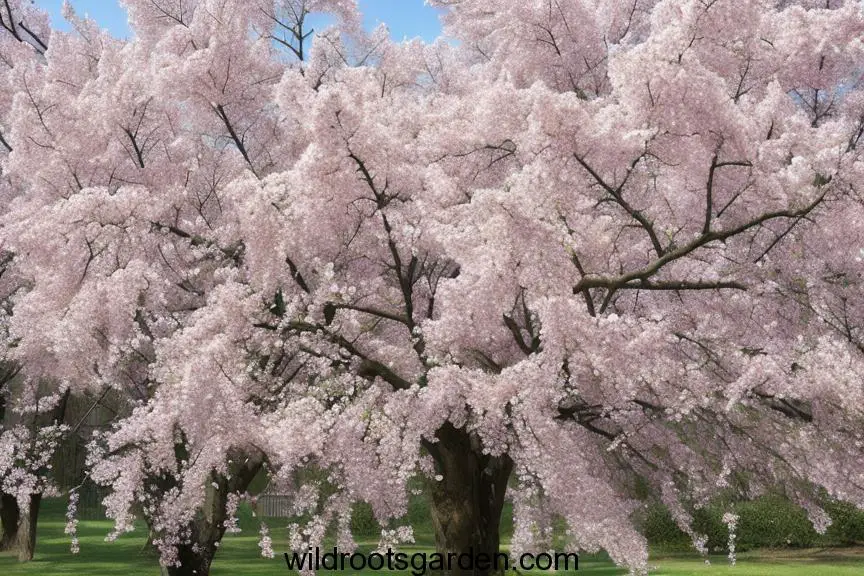
With its pale pink flowers in early spring and golden leaves in winter, the Dream Catcher Flowering Cherry is not only a visual delight but also resilient against pests and diseases.
The Dream Catcher Flowering Cherry (Prunus serrulata) stands as a true masterpiece of nature, with enchanting landscapes and with captivating allure that shines throughout the seasons. This exceptional tree is not merely a fleeting spectacle; it’s a year-long showstopper that delivers a symphony of colors and textures to delight the senses.
As the vanguard of spring approaches, the Dream Catcher Flowering Cherry takes center stage with its enchanting pale pink blossoms. These delicate flowers adorn the branches like ethereal clouds, announcing the arrival of a new season with elegance and grace. Their soft and subtle hues create a soothing ambiance that sweeps through the garden.
But the dreamcatcher’s appeal doesn’t end with the spring blooms. As winter bids adieu and autumn unfurls its warm embrace, the tree undergoes a transformation that is nothing short of magical. The once-pink blossoms give way to the splendor of golden leaves that shimmer like precious coins in the sunlight. This striking transition imbues the landscape with a sense of opulence, making the tree a true focal point.
The Dream Catcher Flowering Cherry’s resilience and beauty make it a treasured addition to a variety of landscapes. Whether gracing the lawn as a solitary statement piece or framing walkways with its elegant branches, it captures attention and adds a touch of refinement to any setting.
This tree’s ability to shine in multiple seasons is a testament to its versatility and adaptability. Planting a Dream Catcher Flowering Cherry is an investment in year-round beauty, a commitment to experiencing the ever-changing tapestry of nature’s offerings. It beckons us to appreciate the dynamic shifts that each season brings and to find solace in the evolving canvas of colors that this remarkable tree paints throughout the year.
8. Smoke Tree: The Enigmatic Smoky Aura
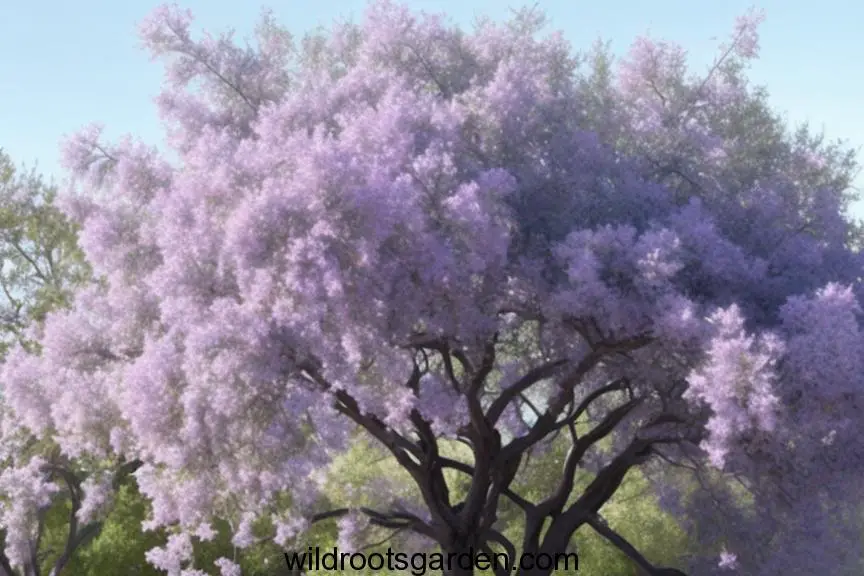
Serving as both a shrub and a tree, the Smoke Tree captivates with its unique appearance and tiny summer flowers that persist through autumn, living up to its smoky namesake.
The Smoke Tree (Cotinus coggygria) casts an enigmatic spell upon the landscape, its ethereal smoky appearance captivating hearts and imaginations alike. This intriguing tree, often referred to as a smoke bush, adds an air of mystery and allure to gardens, enchanting with its unique and captivating visual impact.
As the warmer months arrive, the Smoke Tree reveals its distinctive charm with the emergence of tiny, cloud-like flowers that envelop the branches. These delicate blossoms, borne in plume-like clusters, create an illusion reminiscent of smoky tendrils rising from the foliage. The tree’s evocative name comes to life as it conjures an almost mystical aura, transforming the surroundings into a realm of enchantment.
The Smoke Tree’s allure goes beyond its captivating blossoms. Its foliage takes on a deep purple or smoky gray hue, offering a dramatic contrast that adds depth and dimension to the landscape. Throughout the changing seasons, its leaves maintain this unique color palette, ensuring an ever-present element of intrigue in the garden.
A versatile presence in various landscapes, the Smoke Tree’s beauty shines whether as a standalone feature or as part of a larger composition. Its architectural form and mesmerizing smoky aura make it a natural focal point, drawing the gaze and stimulating curiosity.
Planting a Smoke Tree is an invitation to embrace the enigmatic, to celebrate the unconventional beauty that nature offers. It encourages us to look beyond the ordinary and appreciate the allure of the unusual. As the Smoke Tree unfurls its smoky blossoms and shrouds itself in an air of mystery, it beckons us to explore the captivating intersections of nature and imagination. It’s a reminder that beauty takes on many forms and that even in the mysterious and unexpected, there lies an enchanting world waiting to be discovered.
9. Rhododendron/Azalea: Enduring Elegance
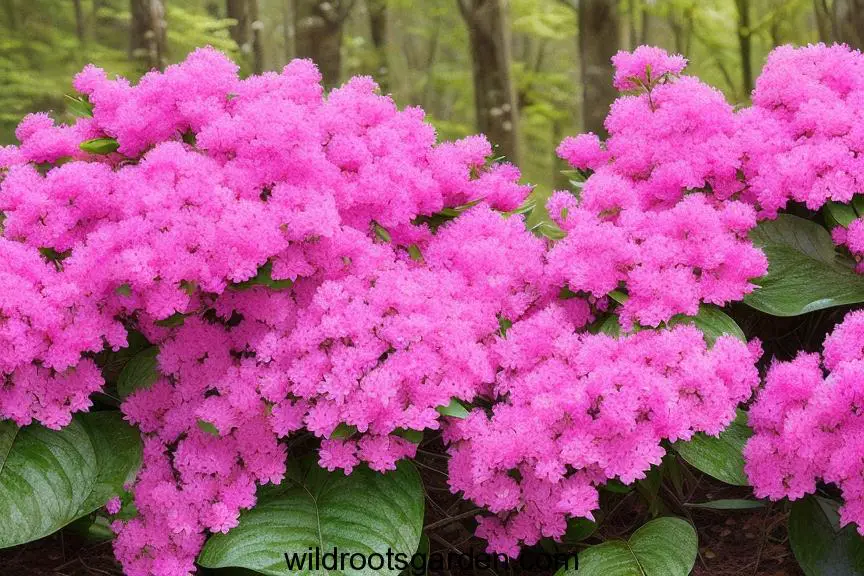
Both Rhododendron and Azalea species, thriving in zones 3 to 9, exhibit a splendid spring bloom, adorning your garden with a colorful and aromatic embrace.
The Rhododendron and Azalea (Rhododendron spp.) stand as enduring symbols of timeless elegance, gracing landscapes with their abundant and captivating blooms. These botanical treasures, belonging to the same genus, paint nature’s canvas with an array of vibrant colors, infusing gardens with a touch of enduring charm that transcends the seasons.
From the first whispers of spring to the gentle breezes of summer, the Rhododendron and Azalea emerge as nature’s masterpieces, adorned with an exuberant display of blooms. Their flowers range from delicate pinks and purples to vibrant reds, oranges, and whites, creating a harmonious symphony of color that uplifts the spirit and captures the eye.
While their blooms may be fleeting, the Rhododendron and Azalea’s impact endures throughout the year. Their evergreen foliage stands as a testament to resilience and provides a lush backdrop for the floral spectacle. As the seasons change, their leaves maintain their vibrant shades, offering a continuous touch of elegance that remains even after the blossoms have faded.
With adaptability as a defining characteristic, these species thrive in a range of climates and settings, from shade-dappled woodland gardens to sun-soaked borders. Whether they’re the focal point of a landscape or complement other elements, Rhododendrons, and Azaleas lend a touch of refinement that resonates with nature’s grace.
Planting these botanical gems is an ode to beauty’s enduring presence, a commitment to experiencing nature’s evergreen embrace. Their elegant blooms and steadfast foliage remind us of the cyclical nature of life and the persistent allure of nature’s creations. As the Rhododendron and Azalea bloom and thrive, they invite us to cherish the fleeting moments of beauty and find solace in the constancy of their enduring elegance.
10. Flowering Almond: Luscious Beauty
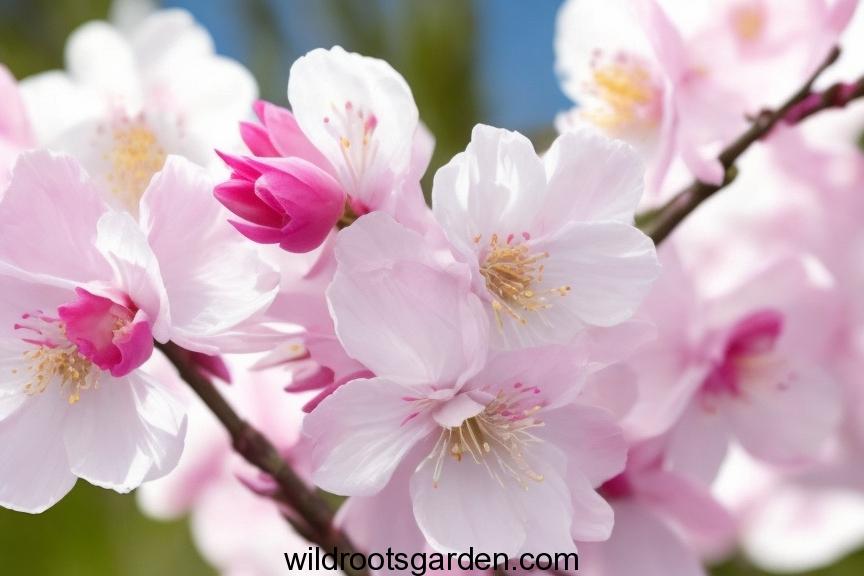
The Flowering Almond, often mistaken for a tree, maintains its allure throughout most of the year, gracing your garden with its full size and captivating charm.
The Flowering Almond (Prunus glandulosa) emerges as a true marvel of luscious beauty, captivating the landscape with its delicate yet captivating blooms that paint nature’s canvas with elegance. This exceptional shrub stands as a living testament to the power of nature to create exquisite artistry that enchants the eye and warms the soul.
As the seasons shift and the weather warms, the Flowering Almond takes center stage with its bountiful display of vibrant pink blossoms. These dainty flowers, resembling clusters of candy-like delights, create a visual spectacle that exudes charm and grace. Their gentle hues infuse the surroundings with a sense of sweetness and serenity.
The Flowering Almond’s beauty isn’t confined to its blooms; its foliage adds to the allure. The shrub’s full and rounded shape, complemented by lush green leaves, creates a verdant backdrop that enhances the impact of the blossoms. Throughout the seasons, this foliage maintains its healthy and vibrant appearance, contributing to the shrub’s overall visual appeal.
Versatile and adaptable, the Flowering Almond finds its place in various landscapes, from formal gardens to more casual settings. Its compact growth habit and delightful blossoms make it an ideal candidate for hedges, borders, or standalone features that command attention.
Planting a Flowering Almond is an invitation to savor the simple pleasures of nature’s beauty. It’s a reminder that even in the smallest and most delicate forms, there lies a potent source of inspiration. As the Flowering Almond graces the garden with its luscious blooms, it encourages us to pause, immerse ourselves in the present, and find solace in the exquisite beauty that nature unfailingly provides.
11. Saucer Magnolia: Ephemeral Beauty
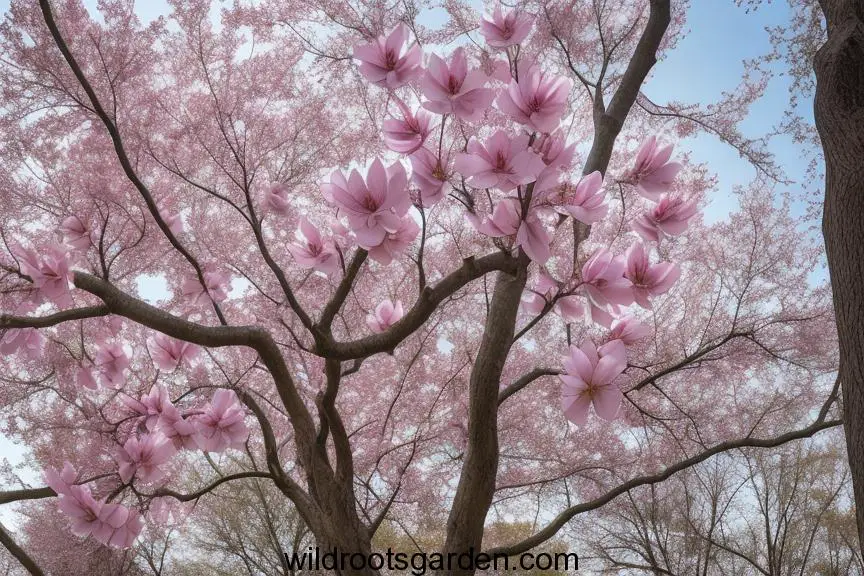
With tea-cup-shaped pink and white blooms in spring, the Saucer Magnolia is a true gem. Even during autumn’s bareness, its gray bark retains allure.
The Saucer Magnolia (Magnolia x soulangeana) stands as a delicate embodiment of ephemeral beauty, gracing landscapes with its exquisite and fleeting blooms that evoke a sense of enchantment. This captivating tree, celebrated for its ornate petals and graceful presence, leaves an indelible impression as it blossoms in a burst of breathtaking colors.
As the grip of winter loosens its hold, the Saucer Magnolia unfurls its iconic flowers, resembling delicate porcelain saucers that have come to life. These tea-cup-shaped blooms are a study in grace and elegance, their soft shades of pink and white creating a vision of serenity and tenderness. Their ephemeral nature adds to their allure, reminding us to cherish the fleeting moments of beauty that nature bestows.
The Saucer Magnolia’s captivating blooms aren’t its only virtue. Even in the absence of flowers, the tree continues to enchant with its gray bark that lends a timeless elegance to its silhouette. As the seasons shift, the tree showcases a range of personalities, from the vibrant hues of spring to the understated dignity of autumn.
Adaptable and hardy, the Saucer Magnolia can be enjoyed in various landscapes, from urban gardens to suburban retreats. Its ability to thrive in a range of environments ensures that its delicate yet steadfast beauty graces a wide array of outdoor spaces.
Planting a Saucer Magnolia is an embrace of life’s transient wonders, an invitation to witness the ephemeral magic that the natural world offers. It encourages us to look beyond the mundane and appreciate the exquisite moments that unfold in nature’s own time. As the Saucer Magnolia blooms in all its ephemeral glory, it whispers to us the beauty of embracing the present and finding joy in the fleeting beauty that is, after all, a reflection of life’s impermanence.
12. Seven-Son Flower: A Global Sensation
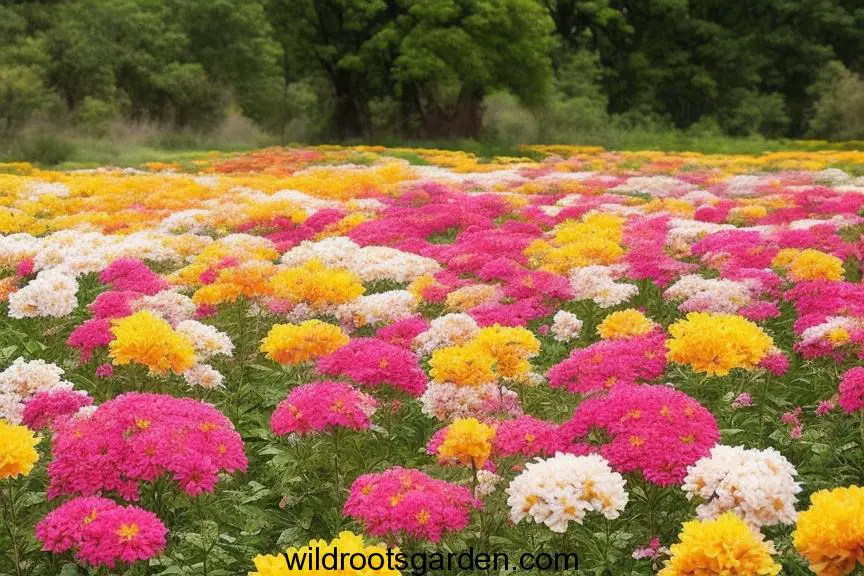
Known worldwide for its pale white flowers with pink bases, the Seven-Son Flower thrives in zones 5 to 8 and adds an enchanting touch to any landscape.
The Seven-Son Flower (Heptacodium miconioides) stands as a global sensation, captivating hearts around the world with its sensational beauty and unique attributes. This remarkable tree, often hailed for its ethereal blossoms and remarkable foliage, has earned its place as a cherished presence in gardens across continents.
With the arrival of late summer, the Seven-Son Flower unfurls its pale white blossoms, each adorned with a delicate pink base. These flowers create a breathtaking spectacle that defies the norm, casting an enchanting spell upon the landscape. Their appearance brings a touch of magic to the garden, signaling the approaching change of seasons.
As the seasons evolve, the Seven-Son Flower continues to impress. Its remarkable transformation includes the emergence of attractive red fruits that replace the summer blooms, offering a feast for the eyes and a banquet for wildlife. These crimson fruits, clustered together like gems, infuse the garden with a sense of vitality and movement.
The Seven-Son Flower’s unique qualities extend to its versatility and adaptability. Thriving in hardy zones 5 to 8, this tree is a testament to nature’s resilience and ability to flourish in diverse conditions. Its slender form and striking features make it an ideal choice for both urban and rural landscapes.
Planting a Seven-Son Flower is an act of embracing nature’s ability to surprise and delight. It reminds us that beauty can be found in unexpected places and that the world of flora holds endless treasures waiting to be discovered. As the Seven-Son Flower graces the landscape with its global allure, it encourages us to celebrate the universal appeal of nature’s creations and to find joy in the shared wonder of its enchanting presence.
13. Crape Myrtle: Southern Beauty
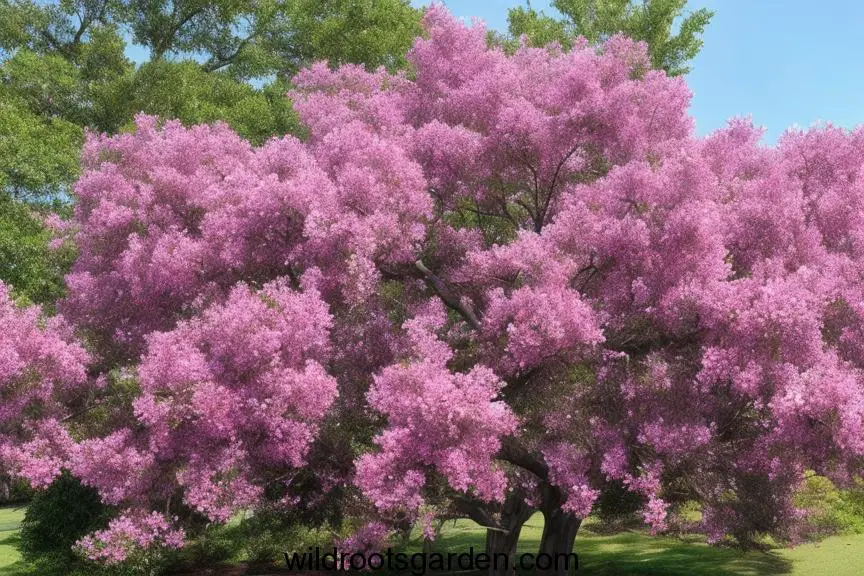
A classic Southern favorite, the Crape Myrtle enchants with its purplish-pink flowers, a symbol of summer’s splendor. It stands strong in zones 7 to 9.
The Crape Myrtle (Lagerstroemia indica) stands as a quintessential symbol of southern beauty, gracing landscapes with its graceful elegance and vibrant blossoms that capture the essence of warm, sunny days. This iconic tree, cherished for its captivating display and enduring charm, has become synonymous with the charm and allure of the American South.
As summer’s warmth blankets the surroundings, the Crape Myrtle comes to life in a burst of purplish-pink splendor. Its lush blossoms cascade down the branches like delicate clusters of confetti, infusing the garden with a celebratory spirit that embodies the joys of the season. These vibrant flowers evoke a sense of joy and nostalgia, painting a vivid portrait of the carefree days of summer.
But the Crape Myrtle’s appeal extends beyond its blooms. As the year progresses, the tree’s textured bark takes on hues of gray, brown, and even cinnamon, adding an additional layer of visual interest to the landscape. This distinctive bark becomes a focal point, captivating the eye even when the flowers have faded.
Adaptable and resilient, the Crape Myrtle finds its home in a variety of landscapes, from suburban gardens to urban retreats. Its ability to thrive in warmer climates and its wide range of sizes make it a beloved choice among garden enthusiasts in the southern United States.
Planting a Crape Myrtle is an homage to the southern spirit, an embrace of the region’s charm and natural beauty. It encourages us to savor the simple pleasures of life and to relish in the exuberance of the changing seasons. As the Crape Myrtle graces the garden with its southern elegance, it invites us to experience the timeless allure that has enchanted generations and continues to define the unique beauty of the American South.
14. Chaste Tree: A Fragrant Haven
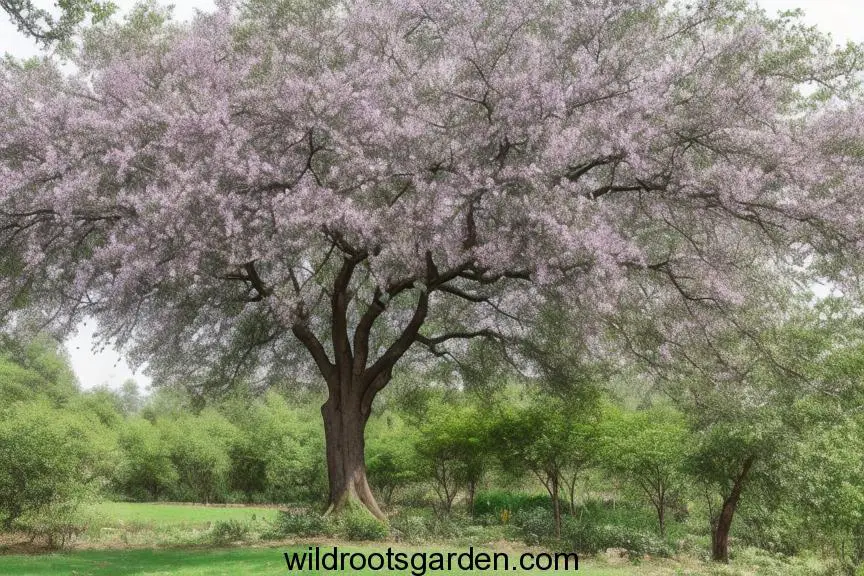
Also known as the Sage Tree, the Chaste Tree delights with its highly fragrant pale purple leaves that persist through the warm summer months.
The Chaste Tree (Vitex agnus-castus) stands as a fragrant haven, offering solace to the senses with its aromatic leaves and captivating flowers that create an enchanting oasis in the landscape. This remarkable tree, known for its distinct fragrance and ornamental beauty, beckons us to find refuge in its delicate blooms and soothing scent.
During the warm months of summer, the Chaste Tree unveils its clusters of highly fragrant, pale purple flowers. These blooms exude a captivating aroma that wafts through the air, creating a sense of tranquility and serenity in the garden. Their gentle hues and sweet scent make the tree a haven for both humans and pollinators alike, forming a symbiotic relationship that enriches the ecosystem.
The Chaste Tree’s allure extends beyond its blossoms. Its foliage, adorned with elegant, palm-like leaves, adds to its visual appeal. The lush green leaves provide a textured backdrop that enhances the impact of the flowers, creating a harmonious composition that resonates with the senses.
This versatile tree thrives in hardy zones 6 to 9 and can be incorporated into a range of landscapes, from cottage gardens to urban settings. Its adaptability to various growing conditions and its ability to tolerate drought make it a reliable choice for garden enthusiasts seeking both beauty and ease of care.
Planting a Chaste Tree is an invitation to immerse oneself in nature’s aromatic embrace, to embrace the therapeutic benefits of fragrant flora. It encourages us to take a moment to pause, inhale deeply, and find solace in the delicate scent that calms the mind and uplifts the spirit. As the Chaste Tree graces the landscape with its fragrant haven, it invites us to create a space where beauty and tranquility coexist in perfect harmony.
15. Higan Cherry: Seasonal Splendor
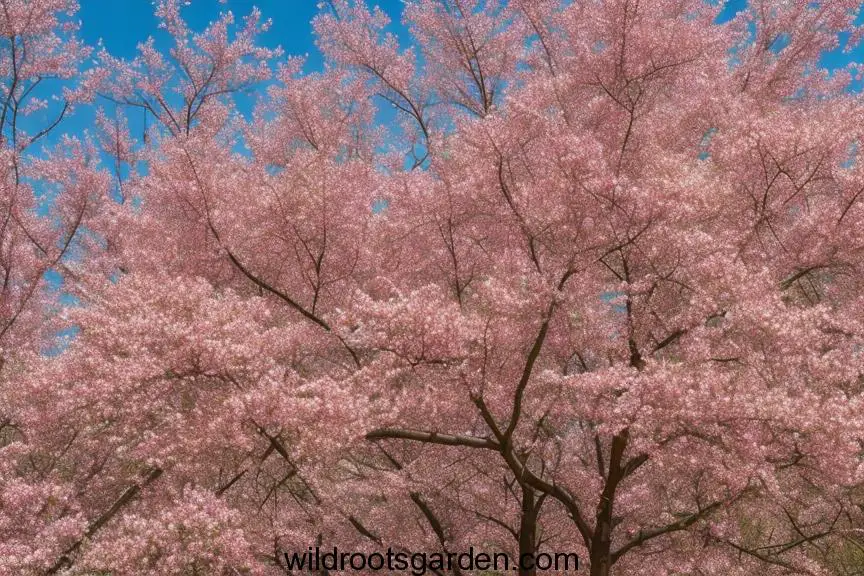
The Higan Cherry graces your garden with pink blossoms in spring and fall, transforming into an ideal choice for small spaces and walkways.
The Higan Cherry (Prunus subhirtella) stands as a testament to seasonal splendor, gifting landscapes with its breathtaking blossoms that paint the canvas of nature with delicate shades of pink. This exceptional tree, celebrated for its dual displays of beauty, offers a mesmerizing journey through the changing seasons.
As the grip of winter begins to loosen, the Higan Cherry graces the garden with its awe-inspiring spring blossoms. Delicate and ethereal, the pink flowers burst forth in a profusion of color, creating a visual spectacle that signals the arrival of warmer days. Their sheer abundance and soft hues evoke a sense of joy and renewal, uplifting the spirit and inspiring awe.
While the spring blossoms are truly enchanting, the Higan Cherry’s autumnal transformation is equally captivating. As fall approaches, the tree once again becomes a beacon of beauty, adorning itself with blooms that pale in comparison to spring’s grandeur yet retain their charm. Against the backdrop of autumn foliage, the pink blossoms create a harmonious interplay of colors that elicit a sense of nostalgia and reflection.
Versatile and adaptable, the Higan Cherry can be enjoyed in various landscapes, from urban parks to private gardens. Its elegant form and charming blossoms make it a natural choice for those seeking a touch of timeless elegance in their outdoor spaces.
Planting a Higan Cherry is an invitation to embrace the cyclical nature of life, to cherish the fleeting yet powerful beauty that each season brings. It encourages us to find solace in the delicate blooms of spring and the subtle charms of autumn. As the Higan Cherry graces the landscape with its seasonal splendor, it reminds us to celebrate the ever-changing tapestry of nature’s creations and to find beauty in every phase of life’s journey.
16. Japanese Horse Chestnut: Versatile Marvel

A resilient street tree, the Japanese Horse Chestnut showcases vibrant spring colors and attracts a multitude of pollinators, making it a multifaceted choice.
The Japanese Horse Chestnut (Aesculus turbinata) emerges as a versatile marvel, gracing landscapes with its multifaceted beauty and offering a range of attributes that make it a treasured addition to gardens and outdoor spaces. This exceptional tree, celebrated for its aesthetic appeal and diverse uses, showcases the power of nature’s versatility.
With its towering presence and broad canopy, the Japanese Horse Chestnut commands attention as a shade provider and a visual anchor in the landscape. Its large, palmate leaves create a lush canopy that offers respite from the sun’s rays, making it a sought-after choice for those seeking natural shade in their outdoor sanctuaries.
The Japanese Horse Chestnut’s appeal extends beyond its form. During spring, the tree adorns itself with elegant, pyramid-shaped clusters of white blossoms that contrast beautifully against the backdrop of its deep green foliage. These blooms attract pollinators and create a spectacle of beauty that evokes a sense of wonder.
But the tree’s offerings don’t end with its visual charm. The Japanese Horse Chestnut is valued for its durable wood, making it a favored choice for a variety of applications, from furniture making to carpentry. Its robust branches make it a sturdy addition to urban landscapes, often gracing streets and parks with its impressive presence.
Planting a Japanese Horse Chestnut is an investment in versatility and a commitment to embracing nature’s many gifts. It encourages us to appreciate the multi-dimensional beauty that trees offer, from their aesthetic allure to their practical utility. As the Japanese Horse Chestnut graces the landscape with its versatile marvel, it reminds us that nature’s creations are truly exceptional in their ability to enrich our lives in myriad ways.
17. Shrub Rose: Timeless Elegance
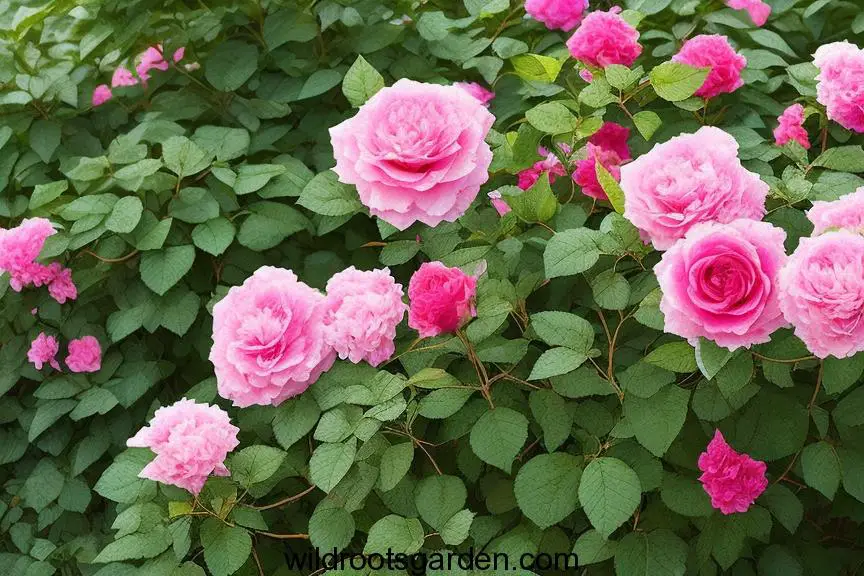
Modern shrub roses, evoking a classic feel, bloom profusely from spring through summer, infusing your garden with their timeless beauty.
The Shrub Rose (Rosa spp.) emerges as a timeless embodiment of elegance, gracing landscapes with its classic beauty and enduring allure that transcends the ages. This remarkable shrub, revered for its exquisite blooms and nostalgic charm, enchants the senses and leaves an indelible mark on the garden.
With each passing season, the Shrub Rose offers a symphony of colors and fragrances that evoke a sense of romance and nostalgia. Its abundant and diverse blooms come in various shades, from delicate pastels to bold hues, creating a kaleidoscope of petals that dance in the breeze. The fragrant embrace of these blossoms adds an olfactory dimension to the sensory experience, transporting us to a realm of cherished memories.
The Shrub Rose’s appeal extends beyond its blooms. Its lush foliage forms a textured backdrop that enhances the impact of the flowers, providing a dynamic contrast that elevates the overall aesthetic. Throughout the seasons, the shrub’s leaves maintain their verdant beauty, ensuring that even when the blooms have faded, there’s a constant touch of elegance in the garden.
Adaptable and versatile, the Shrub Rose finds its place in a variety of landscapes, from formal gardens to cottage-inspired retreats. Its ability to thrive in different growing conditions and its resilience in the face of challenges make it a beloved choice among garden enthusiasts seeking enduring beauty.
Planting a Shrub Rose is an homage to the past and a celebration of the present, a declaration of our appreciation for nature’s ability to create enduring beauty. It encourages us to embrace the delicate balance of tradition and innovation, reminding us that some things, like the elegance of roses, are eternally cherished. As the Shrub Rose graces the landscape with its timeless elegance, it invites us to savor the fleeting moments of beauty and find joy in the enduring charm that nature bestows.
18. Oklahoma Redbud: Spring’s Radiance

Boasting reddish-pink flowers and golden autumn leaves, the Oklahoma Redbud thrives in zones 6 to 9, captivating all year round.
The Oklahoma Redbud (Cercis reniformis) emerges as a radiant beacon of spring’s arrival, adorning the landscape with its brilliant reddish-pink blossoms that paint the world with a burst of color and energy. This remarkable tree, celebrated for its captivating blooms and distinctive foliage, ushers in the season of renewal with its vibrant charm.
As winter’s grasp begins to wane, the Oklahoma Redbud takes center stage, showering the surroundings with a profusion of blossoms that seem to defy the greyness of the previous months. These vivid and eye-catching flowers held closely to the branches, create a stunning contrast against the tree’s unique, heart-shaped leaves. The reddish-pink hue exudes an air of vivacity that resonates with the spirit of spring.
But the Oklahoma Redbud’s allure doesn’t end with its blossoms. As autumn arrives, the tree undergoes a transformation that deepens its visual impact. The once-green leaves turn a subtle golden color, casting a warm and inviting glow that adds to the tree’s appeal throughout the changing seasons.
Versatile and adaptable, the Oklahoma Redbud thrives in hardy zones 6 to 9, making it a reliable choice for a variety of landscapes, from urban gardens to suburban sanctuaries. Its compact size and captivating blossoms make it a favored selection for those seeking a touch of radiance in their outdoor spaces.
Planting an Oklahoma Redbud is an ode to the beauty of seasonal transitions, an invitation to celebrate the cycles of life and nature. It encourages us to embrace the rejuvenating spirit of spring and find joy in the fleeting yet impactful moments of nature’s splendor. As the Oklahoma Redbud graces the landscape with its springtime radiance, it reminds us to bask in the brilliance of the natural world and to revel in the renewal that each season brings.
19. Flowering Crabapple: Seasons of Delight
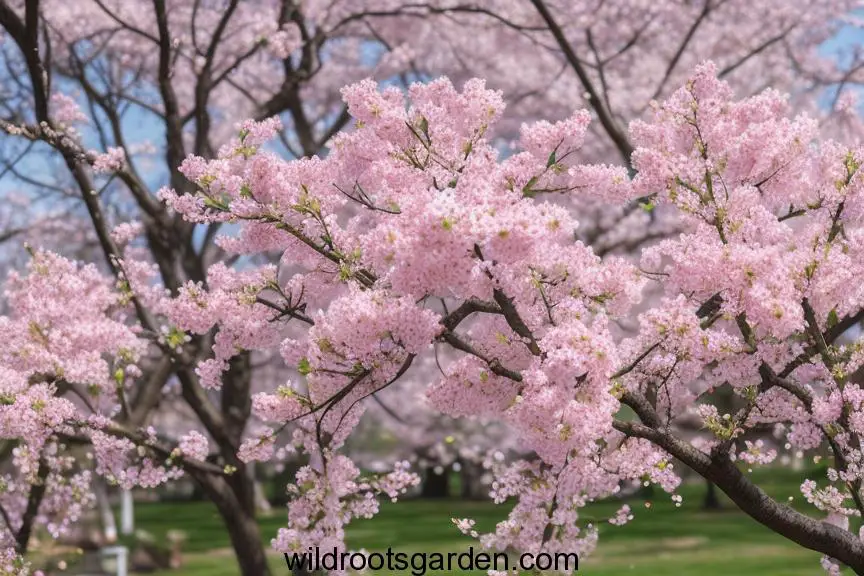
Ideal for zones 3 to 8, the Flowering Crabapple stands as a must-have with its red, pink, and white blooms that blanket your garden in elegance.
The Flowering Crabapple (Malus spp.) stands as a living testament to the changing seasons, enchanting landscapes with its spectacular display of blooms that traverse the spectrum of colors and emotions. This exceptional tree, celebrated for its ornamental allure and captivating blossoms, takes us on a journey through the ever-evolving tapestry of nature’s delights.
From the first whispers of spring to the gentle embrace of autumn, the Flowering Crabapple unfolds a series of chapters that captivate the senses and touch the heart. Its blossoms, ranging from shades of red and pink to pristine white, create a visual masterpiece that evokes wonder and awe. These delicate petals, reminiscent of confetti strewn across the branches, usher in a sense of joy and renewal.
The Flowering Crabapple’s charm extends beyond its blooms. As the seasons evolve, the tree showcases a metamorphosis that keeps the landscape vibrant throughout the year. Its foliage transforms from lush green to autumnal shades of red, gold, and bronze, forming a harmonious symphony of colors that reflect the changing moods of the natural world.
Versatile and adaptable, the Flowering Crabapple finds its home in a range of landscapes, from cottage gardens to urban environments. Its various sizes and growth habits ensure that there’s a suitable cultivar for every outdoor space, from grand estates to cozy backyard retreats.
Planting a Flowering Crabapple is a celebration of the seasons and a tribute to nature’s endless creativity. It encourages us to appreciate the fleeting beauty of each stage in the cycle of life, from the exuberance of blossoms to the quiet elegance of fall foliage. As the Flowering Crabapple graces the landscape with its seasons of delight, it reminds us to find joy in the ever-changing rhythms of the natural world and to embrace the exquisite moments that each season brings.
20. American Fringe Tree: Late Spring Charmer
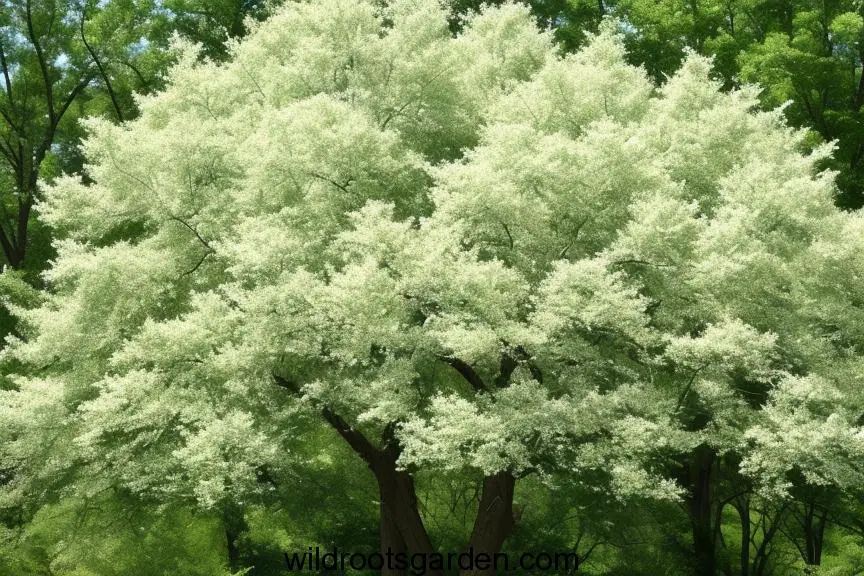
With its late spring white blossoms and red fruits, the American Fringe Tree becomes a haven for birds and pollinators, adding life to your garden.
The American Fringe Tree (Chionanthus virginicus) emerges as a late spring charmer, weaving its enchanting presence into the landscape with its delicate, cascading blossoms that create an ethereal spectacle. This captivating tree, celebrated for its unique and captivating blooms, adds a touch of elegance and whimsy to the outdoor environment.
As spring unfurls its magic, the American Fringe Tree comes to life in a flourish of pure white blossoms that drape gracefully from the branches like delicate fringe. These wispy and fragrant blooms evoke a sense of wonder, resembling a dreamy cascade of lace that transforms the tree into a living work of art. Their soft and pristine hue creates a visual contrast against the backdrop of lush green foliage.
The American Fringe Tree’s allure extends beyond its blossoms. Its foliage forms a verdant curtain that enhances the impact of the flowers, offering a textured and lively backdrop that amplifies the tree’s charm. As the blooms fall, they blanket the ground in a carpet of white petals, creating a scene of enchantment that beckons us to step into a world of pure beauty.
Adaptable and versatile, the American Fringe Tree finds its place in various landscapes, from cottage gardens to urban parks. Its relatively small size and delicate features make it an ideal choice for those seeking a touch of magic and romance in their outdoor sanctuaries.
Planting an American Fringe Tree is an invitation to revel in the poetry of nature, to embrace the fleeting yet powerful moments of beauty that the world offers. It encourages us to pause, immerse ourselves in the present, and find solace in the delicate grace of its blossoms. As the American Fringe Tree graces the landscape with its late spring charm, it reminds us to cherish the enchanting details that make life’s tapestry truly remarkable.
21. Japanese Tree Lilac: Subtle Beauty
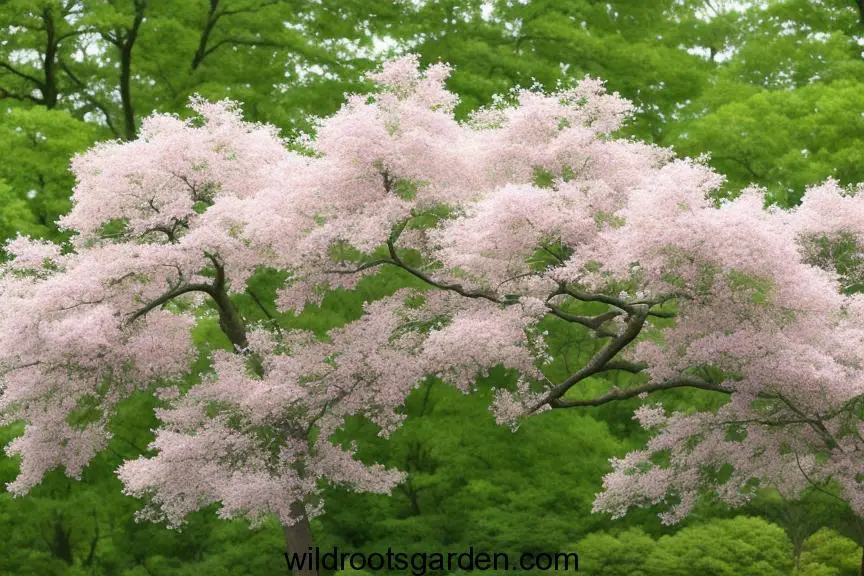
The Golden Eclipse Japanese Tree Lilac enchants with its cream-colored blooms, a perfect fit for zones 4 to 7, and a picturesque addition to any landscape.
The Japanese Tree Lilac (Syringa reticulata) emerges as a beacon of subtle beauty, gracing the landscape with its understated elegance and creamy blooms that captivate with their quiet charm. This exceptional tree, cherished for its refined allure and unique attributes, invites us to appreciate the power of simplicity in the world of flora.
With the arrival of late spring, the Japanese Tree Lilac adorns itself with creamy, delicate flowers that gather in elegant clusters. These blooms, exuding a soft and sweet fragrance, create an atmosphere of tranquility and serenity in the garden. Their pale hues and unassuming demeanor evoke a sense of calm, making the tree a haven for those seeking a respite from the bustle of life.
The Japanese Tree Lilac’s allure goes beyond its blossoms. As the seasons shift, the tree’s foliage takes on a rich green hue that forms a lush backdrop for the creamy flowers. This harmonious interplay of colors creates a serene and balanced visual composition that appeals to both the eye and the soul.
Adaptable and hardy, the Japanese Tree Lilac thrives in hardy zones 4 to 7, making it a suitable choice for a range of landscapes, from urban gardens to suburban retreats. Its relatively compact size and unpretentious demeanor make it a favored selection for those who appreciate the beauty of subtlety.
Planting a Japanese Tree Lilac is a celebration of understated elegance, an embrace of the inherent grace that simplicity brings. It encourages us to find joy in the quiet moments of life and to recognize that beauty need not always be loud and extravagant. As the Japanese Tree Lilac graces the landscape with its subtle beauty, it reminds us to find solace in the gentle whispers of nature and to embrace the enchantment that can be found in the delicate and unassuming details.
22. Glossy Abelia: Year-Round Elegance
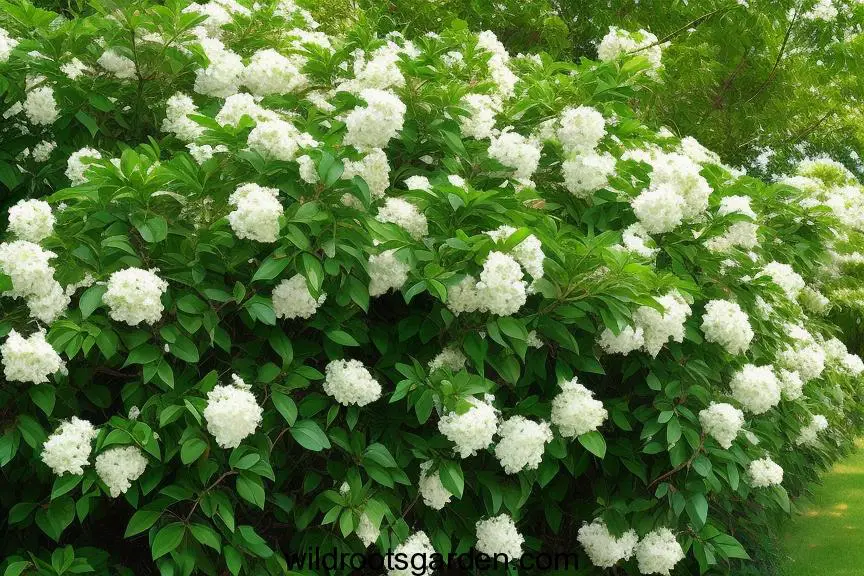
The Glossy Abelia, renowned for its red branches and light pink clusters of flowers, offers captivating beauty throughout the year.
The Glossy Abelia (Abelia x grandiflora) stands as a testament to year-round elegance, adorning landscapes with its evergreen beauty and graceful presence that weaves a thread of charm through the changing seasons. This remarkable shrub, celebrated for its glossy leaves and delicate flowers, offers a continuous symphony of beauty that enchants the eye and soothes the soul.
Throughout the year, the Glossy Abelia presents an enduring display of elegance with its lustrous, dark green leaves. These glossy leaves create a sense of vitality and freshness that remains consistent, even as the seasons transition. Their evergreen nature ensures that the landscape is adorned with a touch of elegance, whether bathed in the warmth of summer or the crispness of winter.
The Glossy Abelia’s allure extends beyond its leaves. During spring and summer, the shrub yields clusters of light pink flowers that form delicate and fragrant clusters. These blossoms add a touch of delicacy and charm to the landscape, creating a soft and inviting atmosphere that evokes a sense of serenity.
Adaptable and versatile, the Glossy Abelia finds its home in a range of landscapes, from formal gardens to informal settings. Its compact size and elegant foliage make it an ideal choice for those seeking a touch of year-round beauty in their outdoor spaces.
Planting a Glossy Abelia is an ode to the enduring grace of nature, an acknowledgment that beauty is not confined to a single season. It encourages us to appreciate the subtle shifts in the landscape and to find joy in the evergreen companionship that the shrub offers. As the Glossy Abelia graces the landscape with its year-round elegance, it reminds us to embrace the beauty that each season brings and to savor the timeless charm of nature’s creations.
23. Hawthorn: A Symphony of Colors and Thorns
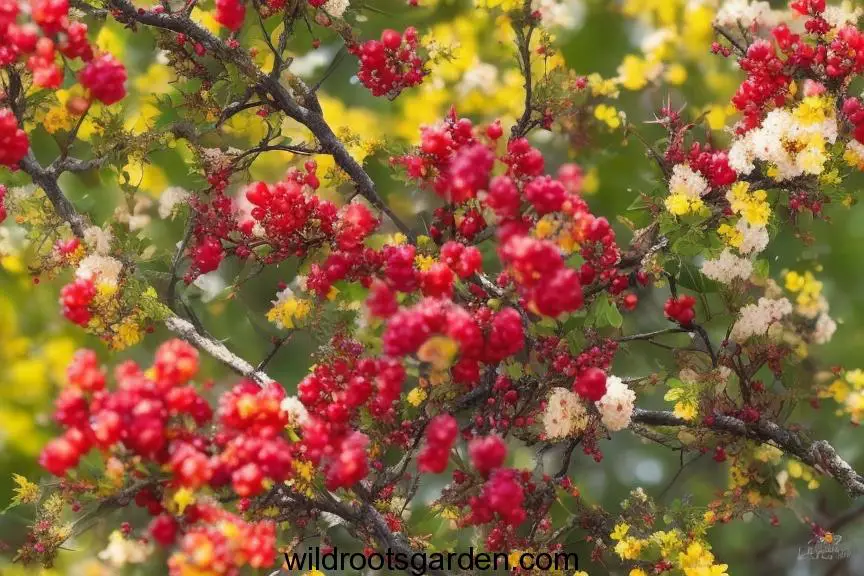
Bearing fragrant flowers in spring and vibrant berries in winter, the Hawthorn thrives in zones 3 to 7, weaving a tale of resilience and beauty.
The Hawthorn (Crataegus spp.) emerges as a harmonious symphony of colors and thorns, gracing the landscape with its breathtaking blossoms and fortified branches that tell a tale of beauty and resilience. This extraordinary tree, celebrated for its vibrant blooms and protective features, weaves a captivating narrative that speaks to the complexity of nature’s creations.
With the arrival of mid to late spring, the Hawthorn bursts forth with a profusion of fragrant flowers in hues of red, pink, and white. These blossoms create a vibrant display that enchants the eye and evokes a sense of wonder. The tree’s ability to simultaneously bear flowers of varying shades paints the landscape with a palette that captures the essence of life’s diversity.
Yet, the Hawthorn’s allure extends beyond its blooms. Its branches are adorned with thorns that form a protective barrier, serving as a testament to nature’s ingenuity in creating a balance between beauty and defense. These thorns, although functional, possess an unexpected elegance that adds to the tree’s overall aesthetic.
Adaptable and hardy, the Hawthorn thrives in hardy zones 3 to 7, making it a versatile choice for various landscapes, from rural fields to urban streets. Its ability to withstand diverse conditions and its resilience in the face of challenges make it a symbol of nature’s unwavering strength.
Planting a Hawthorn is an homage to the intricate dance of life, a recognition that beauty often arises from the interplay of contrasts. It encourages us to embrace the richness of diversity and to find inspiration in the way nature blends the delicate with the rugged. As the Hawthorn graces the landscape with its symphony of colors and thorns, it reminds us that even the most complex compositions can be harmonious and captivating in their unique way.
24. Serviceberry: Early Spring Splendor
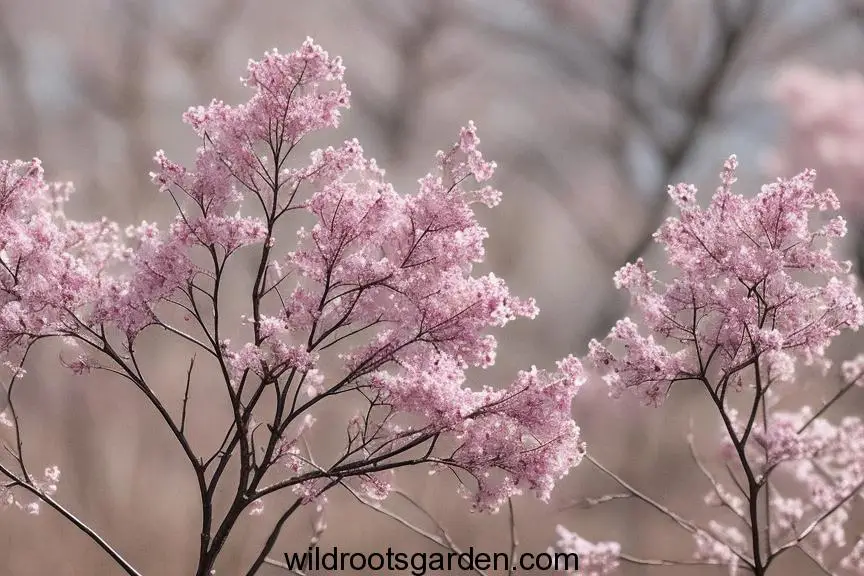
The Serviceberry’s white ornamental flowers herald the arrival of spring, transforming into edible berries that paint your garden in shades of red and purple.
The Serviceberry (Amelanchier spp.) emerges as an embodiment of early spring splendor, casting a spell on the landscape with its delicate blossoms and evolving berries that create a spectacle of beauty and transformation. This exceptional tree, celebrated for its ephemeral blooms and edible treasures, heralds the arrival of spring with a burst of enchantment.
As winter’s grip begins to loosen, the Serviceberry unveils its exquisite white blossoms that cover the branches like a shimmering veil. These blossoms, reminiscent of delicate stars, create a breathtaking sight that ushers in a sense of renewal and anticipation. Their purity and fragility evoke a feeling of wonder, as if nature itself is painting the world anew.
But the Serviceberry’s allure doesn’t end with its blossoms. As the seasons progress, the tree’s flowers give way to round, edible berries that transition from green to red to purplish-black. These berries are not only a visual delight but also a feast for both humans and wildlife, showcasing the tree’s ability to nourish and sustain life.
Adaptable and versatile, the Serviceberry thrives in hardy zones 3 to 8, making it a cherished choice for various landscapes, from natural woodlands to urban gardens. Its relatively small size and dynamic beauty make it a favored selection for those seeking an early spring showstopper.
Planting a Serviceberry is an invitation to celebrate the fleeting moments of nature’s beauty, to savor the transformative journey from blossoms to berries. It encourages us to embrace the cyclical nature of life and find joy in the changing landscapes that each season brings. As the Serviceberry graces the landscape with its early spring splendor, it reminds us to relish the small yet powerful moments that make the natural world so captivating.
25. Goldenrain Tree: Late Summer Radiance
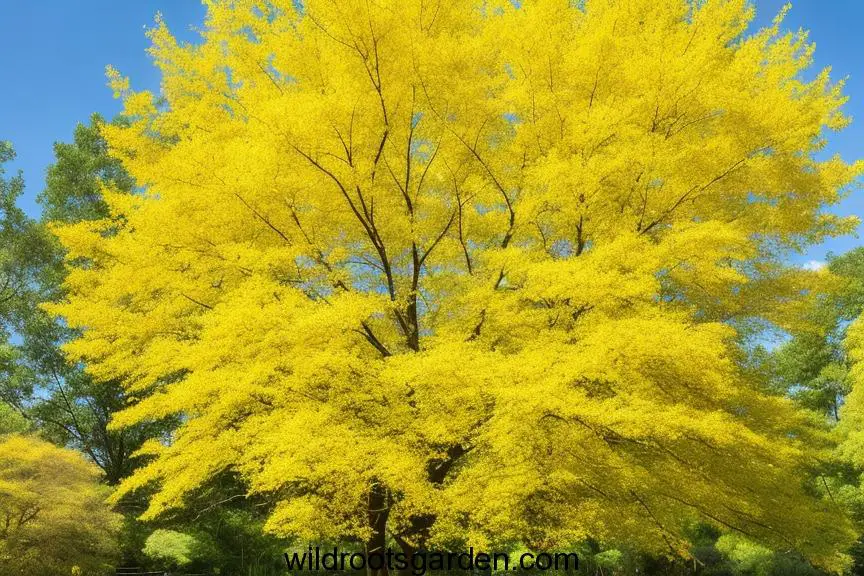
Drooping clusters of yellow flowers grace the Golden Rain Tree during late summer, providing both color and shade for zones 5 to 8.
The Goldenrain Tree (Koelreuteria paniculata) emerges as a radiant beacon of late summer, infusing the landscape with its golden cascades of blossoms that evoke the warmth and vibrancy of the season. This remarkable tree, celebrated for its stunning blooms and unique seed pods, brings a touch of luminosity and elegance to the outdoor environment.
As summer matures, the Golden rain Tree adorns itself with clusters of bright yellow blossoms that hang in delicate panicles. These blossoms, resembling strands of golden rain, create a visual spectacle that captures the essence of the sun’s glow. Their brilliant hue against the backdrop of lush green foliage paints the landscape with a sense of radiance and cheer.
But the Golden Rain Tree’s allure goes beyond its blooms. As the season progresses, the tree’s blossoms transform into distinctive papery seed pods that dangle gracefully from the branches. These lantern-like pods create an artistic display that adds intrigue and charm to the tree’s overall aesthetic, carrying the promise of new life within their delicate enclosures.
Adaptable and resilient, the Goldenrain Tree thrives in hardy zones 5 to 8, making it a versatile choice for various landscapes, from urban streets to suburban yards. Its medium size and captivating features make it a favored selection for those seeking a burst of late-summer radiance.
Planting a Golden Rain tree is an homage to the fleeting beauty of late summer, a celebration of the vibrant hues that nature offers before the season’s transition. It encourages us to cherish the moments of brilliance that come before the quietude of autumn and to find joy in the luminous colors that grace the landscape. As the Golden Rain tree graces the scenery with its late summer radiance, it reminds us to bask in the golden glow of nature’s beauty and to embrace the brilliance that each season brings.
Choosing the Perfect Trees and Shrubs Selecting trees and shrubs is an art that merges beauty with practicality. Beyond aesthetics, it’s crucial to consider your region’s climate and growing zone. Consulting local experts or using USDA guidelines ensures that your choices are well-suited to your environment. Remember, patience is key, as these botanical wonders may take time to mature and grace your garden with their full splendor. Ultimately, the decision to plant long-blooming trees yields a year-round masterpiece of leaves and flowers that will undoubtedly make your garden a paradise of color and life.
FAQs about 25 Trees with Extended Blooming Periods
What are the best trees for a garden that blooms throughout the year?
Explore our list of 25 trees and shrubs with the longest blooming periods, including favorites like the Eastern Redbud and the Saucer Magnolia, to keep your garden vibrant and engaging.
How can I choose the right trees for my region’s climate?
Consider your growing zone and consult local experts or USDA guidelines to ensure the trees you choose are well-suited for your environment and will thrive in your garden.
Can I plant these trees in small spaces?
Certainly! Some options, like the Higan Cherry and the Golden Rain Tree, are perfect for compact yards and spaces near sidewalks, adding beauty even in limited areas.
Are there trees suitable for areas with cold winters?
Absolutely. Many of the trees on our list, such as the Oklahoma Redbud and the Japanese Horse Chestnut, are hardy enough to withstand cold temperatures and add color even during the colder months.
How do I ensure my trees’ long-term health and growth?
Be patient as your trees mature, and provide proper care, including adequate watering, pruning, and maintenance. With time, you’ll enjoy the full splendor of these long-blooming trees.
Final Thoughts: As you embark on your journey to create a captivating garden, remember that selecting trees and shrubs goes beyond aesthetics – it’s about finding the perfect blend of beauty and practicality. Let these 25 remarkable trees be your companions in turning your garden into a year-round masterpiece of color and life. Explore the unique charm of each choice, consider your climate, and watch as your outdoor space blossoms into a haven of natural splendor. Start transforming your garden today – embrace the enduring allure of long-blooming trees and witness the magic they bring to your landscape.


